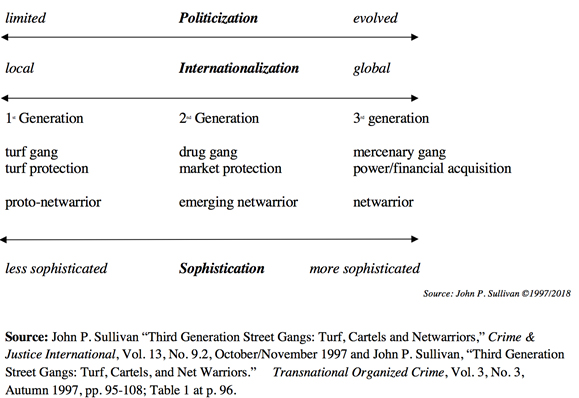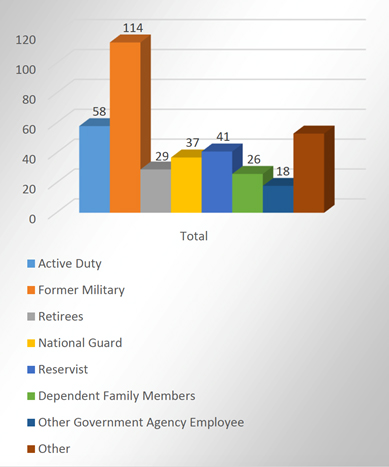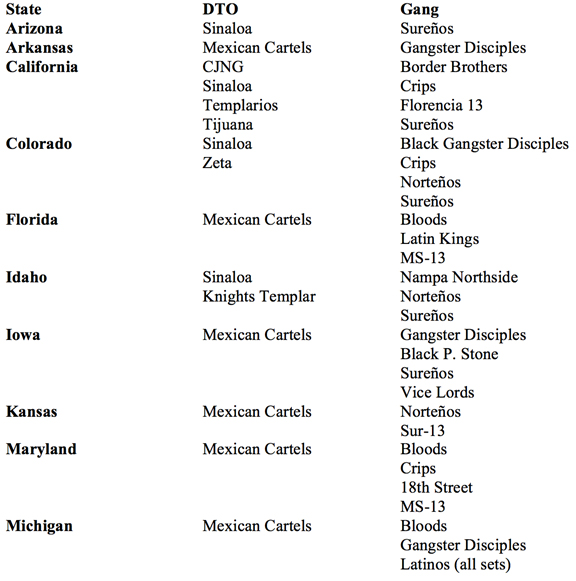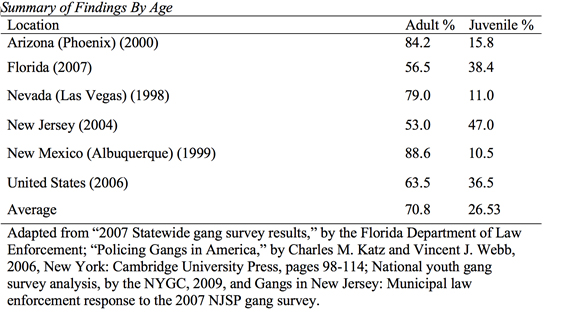Gangs and the Military Note 1: The Increased Threat of Third Generation Gangs with Military-Trained Gang Members
Carter F. Smith
Introduction
In an early exploration of the evolution of group violence in its most common form, John Sullivan found the beginning indicators of Third Generation (3GEN) Gangs.[1] 3GEN gangs pose a significant threat to the safety, security, and future of our communities. 3GEN gangs are highly sophisticated, with goals of political power or financial acquisition.[2] Sullivan & Robert Bunker found that 3GEN Gangs were highly organized and sophisticated criminal organizations that tended to operate in a global environment.[3] Wilson & Sullivan found 3GEN Gangs shared many of the characteristics of terrorists and insurgents.[4]
First generation gangs are those considered primarily turf gangs. Some turf gangs evolve into drug gangs or entrepreneurial organizations with a market-orientation, thus filling the second generation. Some second generation gangs find the need or desire to enhance their position, and ultimately transition to the third generation. Gangs in the third generation include those with a mix of political and mercenary elements who operate or are at least capable of operating in the global community.[5]
Military-trained gang members (MTGMs) have been identified in every wartime period for the United States—from the Revolutionary War to the current conflicts. Active duty MTGMs threaten the cohesiveness of military units and undermine the authority of military leadership, using the military to further their criminal organization’s goals. They are a clear threat to military discipline, bringing corrupt influences, an increase in criminal activity, and a threat to military family members on military installations.
MTGMs increase the level of dangerousness to the community with their warfighter training and share their ability to remain undetected by law enforcement or members of the community, which allows their organization to thrive and grow unchecked. Members of 3GEN Gangs benefit from military training in positions like leadership, intelligence analysis, electronic warfare, psychological operations, and finance.
Identifying the Threat of 3GEN Gangs and MTGMs
Sullivan observed most turf-oriented first generation gangs had loose leadership, with a focus on loyalty and turf protection.[6] They were opportunistic criminals with ill-defined roles and had limited political focus. The more entrepreneurial, second generation type gangs were often drug-centered. They were interested in market protection and focused their endeavors on drugs (and other products) as a business. Second generation gangs were more cohesive, with greater centralization of leadership.
The 3GEN Gangs were mercenary-like with goals of power or financial acquisition and fully evolved political aims. 3GEN Gangs were more sophisticated and operated globally. Authors of the 2009 National Gang Intelligence Center (NGIC) report identified those gangs as national-level street gangs, which have established cells in foreign countries that assist the gangs operating in the United States in developed associations with global drug trafficking and other criminal organizations.[7] Three factors determine a gang’s evolutionary potential: Politicization, Internationalization, and Sophistication.[8]
Politicization is often seen in organizations and communities who respond to external stimuli with which they do not agree. Internationalization for organizational purposes occurs when the vision of the organization’s leadership outgrows the geographic restrictions of its current operation, and gangs have responded to trends towards globalization by transforming their focus to sophisticated criminal activity that is unrestricted by national and international borders. Sophistication occurs in the natural transformation of an organization that follows Tuckman’s five-stage model for group development including forming, storming, norming, performing, and adjourning.[9] Often, sophistication can be the result of continued politicization and internationalization, and requires a unified organization with clearly defined goals. Figure 1 depicts the continuum along which the generations lie.

Figure 1. Characteristics of Street Gang Generations
All three generations of gangs are capable of generating serious domestic instability and insecurity. 3GEN Gangs go beyond the domestic realm and can generate the economic and military power to equal or better that of many nation-states.[10] They have a propensity for indiscriminate violence, intimidation, coercion, transcending borders, and targeting nation-states, and pose significant national security threats.[11] They are both a regional and transnational gang phenomenon.
3GEN Gangs generate instability, reducing the ability of military or law enforcement to control territory, and help erode the legitimacy of nation-states. Manwaring identified the ultimate objective of some 3GEN Gangs and insurgents as a desire to control government.[12] Second and third generation gang members with military training were more disruptive in the communities than gang members in the first generation. The threat posed to law enforcement was even more significant if MTGMs trained other gang members in weapons, tactics, and planning.[13] Whether trained in combat arms, logistics, finance, or other military occupational specialties, gang members with military training should be considered more advanced and dangerous than the gang member without military experience, and the potential threat that MTGMs pose to law enforcement is significant.[14]
A Military-Trained Gang Member (MTGM) is defined as a street gang, prison gang, Outlaw Motorcycle Gang (OMG), or Domestic Terrorist Extremist group member per the applicable jurisdiction's definition, with military training or experience, as perceived by a reasonable, typical, police officer.[15] MTGMs display indicators that they received military training either directly or indirectly. Indicators of military training include the use of military tactics, weapons, explosives, or equipment to conduct gang activity, and the use of distinctive military skills, particularly if gang members are trained in weapons, tactics, and planning, and then pass the instruction on to other gang members. Military tactics include the techniques and strategies taught in a variety of military occupational specialties, ranging from tactical assault to organizational leadership strategies.[16]
Limited research has been conducted on MTGMs in the community.[17] Both the Federal Bureau of Investigations’ NGIC and the Army Criminal Investigations Command (CID) regularly address the phenomenon of MTGMs. The NGIC recently released their 2017 National Gang Report, in which analysts reported gang recruitment of active duty and retired military personnel presented a criminal threat to the military and communities surrounding military installations.[18] They noted law enforcement perceived a serious threat due to the military training and access to military-grade weaponry that gang members may possess. They also noted the involvement of active duty and former military personnel with gangs could lead to more sophisticated and violent gangs throughout the nation. The report included the following examples of MTGM activity:
- In September 2017, a U.S. military service member, a pledged member of the Thunderguards MC, was arrested for his alleged involvement in a gang-related homicide that resulted in the death of two individuals affiliated with the Outcast Motorcycle Club (MC), a rival OMG.
- In May 2017, a grand jury indicted 83 individuals for their involvement with the Nine Trey Gangsters set of the United Blood Nation gang. Federal prosecutors acknowledged that one of the suspects was an active duty military member.
- In January 2017, the Richmond County District Attorney’s Office in California announced the indictment in federal court of 17 members of the Loyalty Over Everything gang for their involvement in crimes ranging from murder and armed robbery to drug distribution and witness tampering. One of the members was an active member of the military.[19]
Among the analysts’ findings in the 2017 study was the response to this survey question: Are Gang Members in the U.S. Armed Forces Using Their Military Training, Skills, Accesses, and/or Clearances to Further the Criminal Activity of the Gang? Figure 2 Shows the results. No other comments or context was included in the NGIC report.

Figure 2: Are Gang Members in the U.S. Armed Forces Using Their Military Training, Skills, Accesses, and/or Clearances to Further the Criminal Activity of the Gang
According to the 2015 NGIC report on gang activity in the U.S., MTGMs pose a serious threat to law enforcement and to the public.[20] They learn combat tactics in the military, then return home to utilize those skills against rival gangs or law enforcement. The NGIC recently found that known or suspected gang members in over 100 responding jurisdictions had sought or obtained employment in the military or a public criminal justice field in the previous two years.[21] Employment with the U.S. military ranked as the most common, followed by corrections. The authors of the 2009 NGIC report observed that “gang members with military training posed a unique threat to law enforcement personnel.”[22] All facets of the criminal justice system throughout the United States (police, courts, and corrections) at the local, state, and federal level have the potential to encounter MTGMs.
The dangerousness of gang members with military training increases even more when they partner with more violent organizations like Mexican Drug Trafficking Organizations (DTOs). The recent (2017) NGIC report documented several disconcerting connections between street gangs and Mexican DTOs, especially the partnership between the Sinaloa Cartel and various factions of the Crips, Gangster Disciples, Norteños, and Sureños.[23] The analysts predicted gangs and DTOs will continue to build fruitful relationships, which are vital for gangs’ survival and growth, and gangs will become more transnational. All of the DTOs are infamous for demonstrating an unparalleled level of violence across North America. The NGIC identified connections between several gangs and Cartels/DTOs, which were compiled in Table 1. There were also connections between prison and outlaw motorcycle gangs and DTOs, but those were removed.[24]

Table 1: Gang and Cartel Associations by State
Military training of individual gang members could ultimately result in more sophisticated and deadly gangs, as well as deadly assaults on law enforcement officers. Additionally, armed forces members’ access to weapons and their perceived ability to move easily across the US border may render them ideal targets for recruitment by or partnerships with DTOs and Cartels.[25] According to the 2015 NGIC report on gang activity in the US, gangs seek employment within the military as a way to secure power. The report observed that MTGMs posed a serious threat to both law enforcement and the public, as they learn combat tactics, increasing the likelihood of a deadly assault on law enforcement officers.[26]
The Military Criminal Investigative Organizations (MCIO) – the CID, Air Force Office of Special Investigations (AFOSI), and Naval Criminal Investigative Service (NCIS) –have identified military personnel with gang membership or affiliation in every branch of the U.S. Armed Forces.[27] The Fiscal Year 2016 Gang and Domestic Extremist Activity Threat Assessment (GDEATA) by the U.S. Army CID was the most recent official report available.[28] There has never been a longitudinal analysis of efforts, failures, and successes from year-to-year made public by the CID, yet the reports have been produced since 2005.
Presence of Gangs in the Military and MTGMs in the community
Contrary to what may be depicted in popular media, more street gang members are adults. Though many street gang members are in there 20s and 30s, most had average ages in adolescence or early 20s.[29] That appeared to have changed, as reflected in the data in Table 2, with a summary of findings, and a comparison of each of the studies’ findings of gang member demographics, by age.

Table 2: Gang Demographics by State
The increase in adult-aged gang members is relevant as the majority of MTGMs are adults. Katz and Webb (2006) found that most (79% or more) gang members in Phoenix, Albuquerque, and Las Vegas were young adults 18–36 years old. The National Youth Gang Center’s (NYGC) annual survey has shown a progressive increase in adult gang members for almost every year since 1996. In 2007, the New Jersey State Police (NJSP) Street Gang Bureau found that most (60%) gang members in 2001 were adults. The Florida Department of Law Enforcement (FDLE) 2007 Statewide Gang Survey indicated 56.5% of the state gang population was adults. So, how many gang members are there in the U.S.? No one has counted since the 2011 NGIC Report. The number of gang members was then estimated at 1.4 million. Reports since then have not estimated or addressed the number.
More recently, Gang Researchers David Pyrooz and Gary Sweeten estimated there were over 1 million juvenile gang members in the United States.[30] If those calculations were accurate, as they appear to be, that would require an upward adjustment of the estimated 1.4 million gang members the NGIC calculated in 2011. An additional 1.1 million adult gang members (if the lower adult-juvenile percentage of 53:47 found by the New Jersey State Police is accurate) to as much as 5.6 million (if the higher adult-juvenile percentage of approximately 85:15 found in one of the studies by Katz and Webb is accurate) would need to be considered.[31] That would mean there were actually at least 2.1 million gang members in the United States when the last recorded NGIC tally was conducted (in 2011) and there were close to 2.6 million in 2013, 2.8 million in 2015, and as many as 3.5 million and 4 million gang members in the United States in 2017 and 2019, respectively, if those numbers continued to climb, based on a conservative estimate.
In the first MTGM surveys of gang cops (in 2009–2010), survey respondents reported roughly 10 percent of their jurisdiction’s gang members were MTGMs. In 2014 and 2015, the average (mean) ranged from 6 percent in the northwest United States to 10 percent in the southern United States. In recent surveys, respondents are simply asked whether they thought the percentage of gang members was 1–10 percent, 11–20 percent, or over 20 percent. The majority lock in at the lower estimates.
If we apply a conservative estimate of 7.5 percent of the gang members in the United States to the adjusted (2011) tally by the NGIC, of an estimated 2.1 million gang members (using the 53:47 of the New Jersey State Police), that would mean there were 147,500 MTGMs in the U.S. in 2017.[32] If a higher adjustment were correct (like 85:15 by Katz and Webb), there would be 6.6 million gang members in the U.S. [33] That would mean there were up to 495,000 MTGMs in the US in 2017. That many MTGMs demonstrates an alarming domestic and national security threat that includes a number of potentially significant implications for government leaders in the US, and in other countries where 3GEN Gangs are prevalent.
Summary
All three generations of gangs are capable of generating serious domestic instability and insecurity. 3GEN Gangs go beyond the domestic realm and can generate the economic and military power to equal or better that of many nation-states. They have a propensity for indiscriminate violence, intimidation, coercion, transcending borders, and targeting nation-states, and pose significant national security threats. They are both a regional and transnational gang phenomenon. Not all gangs qualify for the second and third generation classifications, as profit-making enterprises, intent on expanding outside of their neighborhoods and cities. Though first and second generation gangs would pose an obvious threat to the local military community, those in the third generation are of primary concern. Gang members in such sophisticated criminal organizations would be able to escape detection while applying offensive tactics that only the military can teach.
MTGMs pose a real threat in our communities. The majority of the population does not realize they exist, nor are they aware of the seriousness of the threat to the safety of the community. This note was intended to promote the awareness of the MTGM problem in our society and encourage scholars, practitioners, and government leaders to conduct or support research concerning this issue and find strategies to control the problem or mitigate the effects. Military leaders should pay more attention to the gang members in their unit and their whereabouts and have better communication with community law enforcement agencies, as the presence of MTGMs is a significant predictor of serious and violent crimes.
Additional Reading
Robert J. Bunker and John P. Sullivan (2013). Studies in Gangs and Cartels. London: Routledge.
National Gang Intelligence Center [NGIC] (2005-2017). National Gang Reports 2005-2017. Washington, DC: National Gang Intelligence Center.
Carter F. Smith (2017). Gangs and the Military: Gangsters, Bikers, and Terrorists with Military Training. Lanham, MD: Rowman & Littlefield.
U.S. Army Criminal Investigations Command [CID] (2006-2017). Fiscal Year 2005-2016 Gang and Domestic Extremist Activity Threat Assessments.
End Notes
[1] John P. Sullivan (1997). "Third Generation Street Gangs: Turf, Cartels, and Net Warriors." Transnational Organized Crime, Vol.3, No.3, Autumn 1997, pp.95-108.
[2] John P. Sullivan and Robert J. Bunker (2007). “Third generation gang studies: An introduction.” Journal of Gang Research, 14(4), 1-10. Retrieved from http://scholarship.claremont.edu/cgu_fac_pub/136/.
[3] Ibid.
[4] G.I. Wilson and John P. Sullivan (2007). “On gangs, crime and terrorism.” Defense and the National Interest. February 28. Retrieved from http://d-n-i.net/fcs/pdf/wilson_sullivan_gangs_terrorism.pdf.
[5] Sullivan & Bunker, 2007.
[6] Sullivan, 1997.
[7] National Gang Intelligence Center [NGIC] (2009). National gang report - 2009. Washington, DC: National Gang Intelligence Center.
[8] Sullivan & Bunker, 2007.
[9] Bruce Tuckman (1965). “Developmental sequence in small groups.” Psychological Bulletin, 63, 384-399.
[10] Ibid.
[11] Ibid.
[12] Max G. Manwarning (2005). Street gangs: The new urban insurgency. Carlisle Barracks: Strategic Studies Institute, US Army War College. Retrieved from http://www.strategicstudiesinstitute.army.mil/pubs/.
[13] NGIC, 2009.
[14] Ibid.
[15] Carter F. Smith (2017), Gangs and the Military: Gangsters, Bikers, and Terrorists with Military Training. Lanham, MD: Rowman & Littlefield.
[16] Ibid.
[17] Carter F. Smith (2011). “Documenting the pilot: The military gang perception questionnaire (MGPQ).” Journal of Gang Research, 18(4) 1-17; Carter F. Smith and Yvonne Doll (2012). “Gang investigators perceptions of military-trained gang members.” Critical Issues in Justice and Politics, 5(1), 1-17, https://www.suu.edu/hss/polscj/journal/v5n1.pdf; Carter F. Smith (2015). “Military-Trained Gang Members – Two different perspectives.” Journal of Gang Research, 22(2), 23-38; and Carter F. Smith and Joshua Harms (2018). “The Threat of Street Gangs, Outlaw Motorcycle Gangs, and Domestic Terrorist/Extremist Groups with Military-Trained Members.” Small Wars Journal, 23 March, http://smallwarsjournal.com/jrnl/art/threat-street-gangs-outlaw-motorcycle-gangs-and-domestic-terroristextremist-groups.
[18] National Gang Intelligence Center [NGIC] (2017). National Gang Report - 2017. Washington, DC: National Gang Intelligence Center.
[19] NGIC 2017.
[20] National Gang Intelligence Center [NGIC]. (2015). National Gang Report - 2015. Washington, DC: National Gang Intelligence Center.
[21] Ibid.
[22] NGIC 2009 (p. 13).
[23] NGIC 2017.
[24] NGIC 2017.
[25] NGIC 2015.
[26] NGIC 2015.
[27] National Gang Intelligence Center [NGIC] (2013). National Gang Report - 2013. Washington, DC: National Gang Intelligence Center.
[28] U.S. Army Criminal Investigations Command (2017). Fiscal Year 2016 (FY16) Gang and Domestic Extremist Activity Threat Assessment (GDEATA).
[29] Malcom W. Klein (2005). “The value of comparisons in street gang research.” Journal of Contemporary Criminal Justice, 21(2), 135-152. doi:10.1177/1043986204272911.
[30] David C. Pyrooz, and Gary (2015). “Gang Membership Between Ages 5 and 17 Years in the United States,” Journal of Adolescent Health, 1, 3. Retrieved from https://www.ncbi.nlm.nih.gov/pubmed/25682209.
[31] New Jersey State Police (2007). Gangs in New Jersey: Municipal law enforcement response to the 2007 NJSP gang survey. Trenton: New Jersey Department of Law & Public Safety Division of the New Jersey State Police Intelligence Section. Retrieved from http://www.state.nj.us/njsp/info/pdf/njgangsurvey-2007.pdf and Charles M. Katz and Vincent J. Webb (2006). Policing gangs in America. New York: Cambridge University Press.
[32] New Jersey State Police, 2007.
[33] Katz and Webb, 2006.
